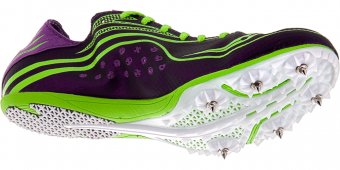
Dirt Track Racing shoes
 Spikes are designed to meet the needs of runners of various event disciplines, not merely for runners in one event. It is rare to see a spike that is only compatible for the 400m, 800m, 5000m, or any singular race. Spikes are manufactured to fit the needs of athletes who fall into five categories: short sprints, long sprints, middle-distance, long-distance, and cross country.
Spikes are designed to meet the needs of runners of various event disciplines, not merely for runners in one event. It is rare to see a spike that is only compatible for the 400m, 800m, 5000m, or any singular race. Spikes are manufactured to fit the needs of athletes who fall into five categories: short sprints, long sprints, middle-distance, long-distance, and cross country.
Field shoes and spikes are tailor-made for specific events, making them easy to spot. Usually, the names of the models will represent the event for which they are worn. For example, the Saucony Uplift HJ is used for the high jump. Abbreviations such as “TJ” for triple jump, “SD” for shot put and disucs, and “Jav” for javelin are very common.
For sprinters, forward propulsion, minimizing the time spent on your feet, and your drive phase is of vital importance. Sprint spikes are designed to enhance your form and speed from the starting blocks to the finish line.
How a sprint-specific spike can help you
You can quickly detect a sprint spike by observing the plate on the outsole. They often sport an aggressive plastic mold underneath the forefoot to force runners on their toes and to decrease foot contact with the ground–exactly what speed demons need to shave valuable fractions of a second.
Spikes designed for sprinters of the linear variety–55m or 100m dashers–have a full-length plate–one that spans from the forefoot to the heel. These best serve runners who compete in events that have one or no turns—the shoe is designed for sprinting down straightaways and are relatively stiff.
Sprint models with 200m-500m runners in mind usually do not contain a plate that covers the heel and are more flexible.
Both short and long sprint models employ a firmer spike plate beneath the forefoot to yield a “recoil” effect, so that with every step, the shoe is responsive enough to give you some more “spring” in your stride. More spring = quicker steps.
The outsole is largely made of plastic, so it will feel firm and rigid upon first wear. The overall fit feels more comfortable and natural when running on a rubber track surface.
The upper of the shoe is designed with sprinters’ needs in mind as well. The upper in any spike is, generally, more narrow than what athletes are accustomed to in running shoes. Sprint spikes grip the foot firmly to lock it in place to encourage better running economy. Some models may even employ a strap above the shoe tongue or a zipped upper.
The spikes
Now let’s talk about actually wrenching the spikes in. As a rule of thumb: The shorter the event, the more spikes you’ll need.
Traditionally, short sprint spike plates will have about 7 – 10 pins per shoe to foster greater traction. Since flexibility is a greater concern for longer sprints, spikes for these athletes will only have 6 – 8 pins. Wrench the spikes in securely lest they fall out mid-race. Do not wrench them too tight as you may risk stripping the spike wrench.
NOTE: Long sprinters may prefer a full-length plate, which is perfectly suitable for the 200m and up. Just make sure that you’re comfortable, you don’t want to question yourself while you’re in the blocks.
For the runner who has found his or her home in the 800m or 1500m/1600m/Mile (herein referred to as “the mile”), shoe companies have built spikes with both your leg speed and endurance in mind.
How a middle-distance spike can help you
For those running a multi-lap race and making at least two turns (yes, I’m directing this to the half-milers and milers that have a spot on the 4x400m relay) middle-distance spikes will have an appropriate blend of flexibility, torsion (ability to turn and flex), and rigidity. They will be less rigid than sprint spikes, so they should feel less stiff.
Take a look at the middle distance spike plate. Compare it to the plates you see on both sprint varieties. You may notice that the forefoot is not completely covered in plastic. You may also observe that the shoe looks a tad softer underneath the arch. Unlike sprint spikes, mid-distance performance shoes have a very thin layer of ultralight EVA foam to provide a small dose of cushioning. After all, you’re spending more time running your event, so you need to be a little more comfy.
Manufacturers create inlets of the EVA foam in the spike plate to allow some flexibility and torsion–a necessity for the proper toe-off in each stride. With a semi-aggressive spike plate and a razor-thin midsole, you have a perfect shoe for control in the early stages of the race as well as some pop for your finishing kick. You’ll be glad you’re in the proper footwear when you’re driving home in the final 150 meters. Just be sure to shake your competitors’ hands after you win.
Most importantly, these bad boys are light. Technology has vastly improved in the past few years, leading many to marvel at the featherweight nature of middle-distance and long-distance spikes. Some shoes are as light as three ounces; you may even forget you have them in your bag.
Ultimately, a middle-distance spike is firm enough to keep you on your toes when you need to be, but flexible enough to go the distance.
The spikes
Spikes for 800m runners and milers often come with a 6-pin plate and can be worn by an athlete who dabbles in the 400m too. Less pins = lighter weight.
Wrench the spikes in firmly. The longer the distance you’re running, the greater the chance of losing a few. Don’t forget to take the time to clean the spike plate. Middle distance and long distance runners manage to accrue dirt and debris around the spikes. If not cleaned properly, it can make removing old spikes quite difficult.
When endurance is the name of the game, every bit counts: You want a shoe to be light, flexible, and durable.
How long-distance spikes can help you
For long-distance spikes, manufacturers introduce a bit more foam than they do at the middle-distance level to achieve greater flexibility. Likewise, shoe companies implement slightly larger foam inlets in the spike plate for pliability’s sake. A less aggressive plate is especially important for those competing in the 5, 000m or 10, 000m. Being propped up on your toes for 3.1 miles or more may result in calf pain and soreness, among other injuries.
The upper of the distance spikes is also important. Luckily, shoe durability is improving along with shoe weight. Each company uses special techniques to ensure that the mesh in the upper is durable but also breathable–and more importantly, really light. So, even on those hot days (when the track is 20 degrees warmer than the air temperature), the shoe will ventilate efficiently.
Long-distance spikes are often a few fractions of an ounce lighter than middle-distance spikes. .
The spikes
The spike plate for distance runners requires the least maintenance: There are usually only 4 – 6 pins.
Long distance runners should monitor the condition of the spikes. Since these runners are covering the longest distances at meets, the spikes will dull at a much quicker rate. Remove the spikes before they become too dull. Otherwise, the spikes (or what used to be spikes) may be stuck for good.









